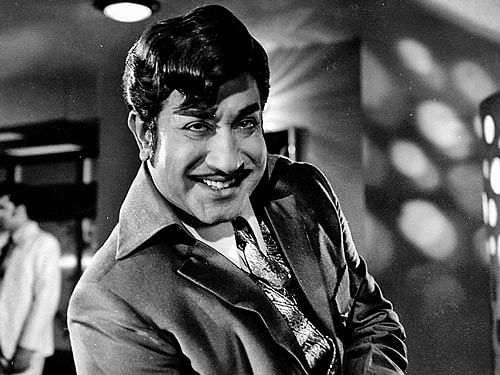
I always thought that bit about Sivaji Ganesan and Marlon Brando was apocryphal, but apparently not — Brando visiting India did actually say, “Sivaji Ganesan can act like me but I can’t act like Sivaji Ganesan.” Sivaji’s acting, we once thought, was over the top, but in retrospect, those emotionally wrenching, highly charged performances are some of the most significant, emblematic instances of Indian acting.
To the usual charge of overacting, Sivaji apparently always retorted: “What is acting? It means doing something that is not natural. So then where is the question of overacting? When your mother dies, what do you do? You shout amma and cry, don’t you? Your instant reaction is to cry out loud. Not sit quietly covering your eyes with your hands. That’s exactly what I do in my films.”
Recently, I came across two restored prints of Thillana Mohanambal (1968) and Thiruvilaiyadal (1965), two of his “musical masterpieces.” These two films (and their songs) are considered Indian classics for several reasons: they are classics in the minds of moviegoers, they are set in a classical period (Thiruvilaiyadal has a timeless, mythological setting, while Thillana Mohanambal is set around the turn of the last century) and they are soaked in classical Carnatic and folk music. What is straightaway interesting about Thillana Mohanambal is the way Carnatic instrumental tracks supersede songs. One of the central characters in the film is a nadasvaram player, and we hear four concert pieces by him.
The talents involved in both films, both in front of the camera and behind, are numerous. K V Mahadevan, the music composer for both films, was brilliant at fusing traditional Carnatic ragas and devotional songs (especially the kirtanas of the Tamil poet-saint, Thyagaraja) with film music. The playback singers he employed were a striking combination of accomplished vocal maestros such as T R Mahalingam, K P Sundarambal and M Balamuralikrishnan, and gifted popular singers such as L R Easwari, P Susheela, and T M Sounderajan. The poet lyricist was always Kannadhasan. M P N Sethuraman and M P N Ponnuswamy are the playback nadasvaram players.
Of the two, my favourite remains Thillana Mohanambal. In front of the camera there are, first of all, the two acting legends, Sivaji and Padmini. And with them are a host of well-loved ensemble actors (both comic and dramatic) such as Nagesh, Manorama and Balaiya, to name only three of the usual suspects. The settings for the songs (and the nadasvaram concerts) are in temples, palaces and courtyards.
Sivaji plays a renowned, respected, and accomplished nadasvaram player. Padmini plays a renowned, respected and accomplished classical Bharathanatyam dancer. As people, however, both are proud, passionate and tempestuous. They fall in love, but their fierce loyalty to their respective art forms confronts them with a great (if silly) challenge: did dance evolve from music or music from dance? She has to dance till he stops playing; he has to keep playing till she stops dancing. Whoever loses will have to give up playing or dancing.
Sivaji, who usually looks stocky in most other roles, looks wiry, handsome and distinguished here. Padmini has never looked more vivacious. Sivaji beautifully fakes playing the nadasvaram: looking at the emotions running on his face, and his dancing fingers, you could swear he’s the one playing the instrument. Padmini, of course, didn’t have to fake the dancing. What set the film apart immediately are the scenes featuring the nadasvaram and the dancing. Though the songs are not many, they are a delight too.
T G Vaidyanathan, who was one of India’s most interesting and endearing culture critics, once noted about Sivaji’s genius: “His physical endowments do not bespeak the poetry of stormy romance, they are the very prose of ordinary, South Indian life. We must look elsewhere to decipher the marks of his prowess as an actor. He had a ballet dancer’s sense of timing. It is his walk, his carriage, that often comes to mind. He employs a casual, cowboy’s gait, head archly tilted to the left, spring-heeled, lissome, the balance adroit… The great swinging amplitudes of his magnificent voice that has carried him to the dizzying pinnacles of fame: in his hoarse fractured cry D-O-C-T-O-R, or in the half-mocking, half-despairing catch in the lower octaves of his rain-drenched voice.”